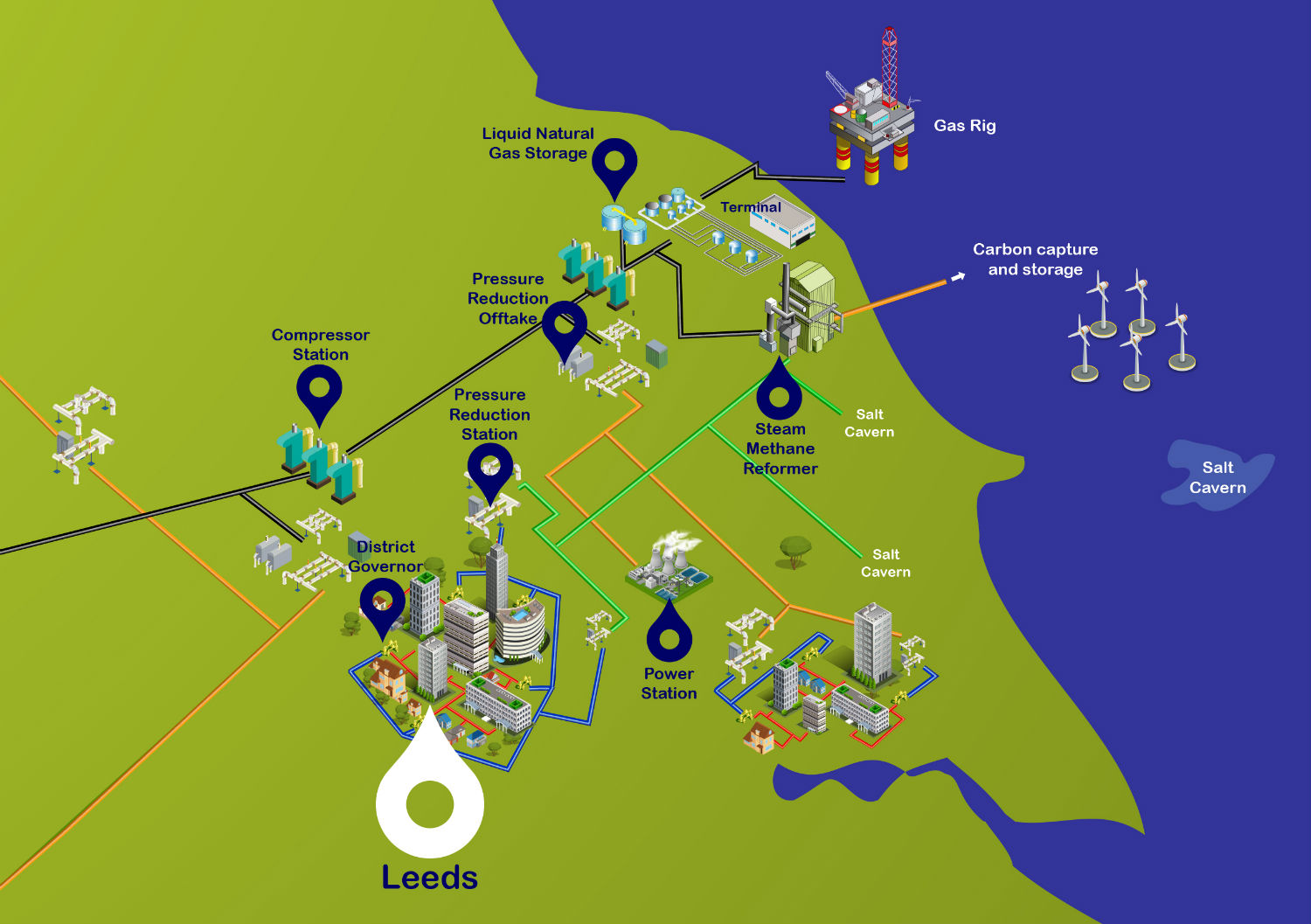Brexit or no Brexit, the UK government is committed under the Climate Change Act 2008 to reducing greenhouse gas emissions by 80% of 1990 levels by 2050. Whilst electricity generation looks on track to achieve this, transport and heat are nowhere near. So government and industry are looking at potentially radical solutions. Could hydrogen be the answer?
The problem
Four-fifths of British households use natural gas for heating and cooking. The burning of fossil fuels accounts for 17% of the UK's emissions in 2015, according to the Committee on Climate Change. These figures need to reduce significantly if the UK is to meet its 2050 emissions targets. Using hydrogen for heating and transport could be a way of achieving this, as hydrogen combustion produces just heat and water, with zero carbon emissions. Producing hydrogen in a low-carbon way is another matter.
Producing hydrogen
There are two main ways of producing hydrogen at scale at the moment and the cheapest is Steam Methane Reforming, or SMR, of natural gas. Converting natural gas to hydrogen using SMR produces carbon dioxide, so it ends up increasing overall CO2 emissions. To make it low-carbon, it needs to be combined with carbon capture and storage (CCS). The CCS industry in Britain has yet to get off the ground, not helped by the government's sudden withdrawal of funding for the CCS commercialisation competition in November 2015, but introducing large-scale hydrogen production for heating should make investors more confident to invest in CCS technology.
The second main way of producing hydrogen is by electrolysis of water, which converts electricity to hydrogen. This is much more expensive than SMR (even with CCS) and requires more energy, but it produces very pure hydrogen. It is also more small-scale than SMR but can have a use to convert and store as hydrogen excess power generated by renewable installations, and to power low emission vehicles – more on this below.
Hydrogen is very versatile as it can be transported as a gas by pipeline, by road in tankers as a compressed gas, or be produced locally in a decentralised system. This means it has many potential uses in an overall energy system.
Hydrogen for heat
The number of hydrogen projects that have received Network Innovation Allowance (NIA) and Network Innovation Competition (NIC) funding shows that hydrogen is starting to be taken seriously by the power industry as a decarbonisation option. Perhaps the most high-profile, or at least the most ambitious, project is H21 Leeds Citygate, a proposal to convert the entire city of Leeds to 100% hydrogen, fuelled by four SMR reactors on Teeside and with CCS and excess hydrogen storage in salt caverns under the North Sea. Led by Northern Gas Networks (NGN), the project study concluded that "converting the UK's gas network to hydrogen is technically possible and economically viable" and that it would lead to a 73% reduction in CO2 emissions from heat but also from transport and power generation.
The next stage is to prove that hydrogen is safe to use in the domestic gas distribution network, and NGN have applied (and passed the initial screening) for NIC funding to do this. They are also looking at extending their network analysis of Leeds to other cities across the UK, working with other gas distributors.
The Leeds H21 project
 ©Northern Gas Networks - to read more about H21, visit Northern Gas Networks’ website www.northerngasnetworks.co.uk. You can also watch the H21 film at http://bit.ly/2rnYbjy
©Northern Gas Networks - to read more about H21, visit Northern Gas Networks’ website www.northerngasnetworks.co.uk. You can also watch the H21 film at http://bit.ly/2rnYbjy
Other current projects include:
100% Hydrogen – a Scotia Gas Networks NIA project to research and evaluate the feasibility of constructing and demonstrating a 100% hydrogen distribution network.
HyDeploy – a consortium led by National Grid plc and NGN is carrying out a three-year NIC-funded trial of injecting a blend of natural gas and hydrogen into Keele University's private gas distribution network, involving building a hydrogen production plant and injection system at the university. Regulations only permit 0.1%vol of hydrogen in the UK gas network, but using Keele's private network, NGN will be able to trial injection of up to 20% hydrogen.
BEIS – are setting up a three year innovation programme with £25 million funding to de-risk and demonstrate the use of hydrogen for heat in UK homes and businesses, which will inform future policy development.
Hydrogen supporting renewable electricity
The process of electrolysis converts electricity to hydrogen gas. Although not as efficient as SMR, it can be a way of producing "green" hydrogen if renewable electricity is used. There are times, such as windy nights, when the output of renewable energy is higher than the demand for electricity. Using electrolysis at such times can be a way of storing renewable energy as hydrogen gas and avoiding grid constraints. The hydrogen gas can then be used to meet periods of increased electricity demand, by converting it back into electricity using fuel cell technology.
The 'Surf 'n' Turf' project in Orkney is a good example, where surplus electricity generated by tidal power and an onshore wind turbine is converted to hydrogen by a 500kW electrolyser. The hydrogen is stored as compressed gas then transported on a trailer by road and sea to Kirkwall, where it powers a fuel cell to generate clean electricity on demand. This is being extended using European funding so that the hydrogen will also be used to refuel a fleet of ten vans and two hydrogen-powered boilers to provide zero carbon heat.
Hydrogen for transport
The transport sector seriously needs to decarbonise. Last year the proportion of renewable energy used in transport actually fell from 4.9% to 4.2%. Air pollution is also in the news, with NOx emissions from diesel cars being a particular issue. Electric vehicles have been lauded as the solution, but they are not the only solution as they bring their own problems for the electricity grid. There are various horror stories such as a brownout if six cars on the same street plug in to charge at the same time, and threats of costly grid reinforcement being needed if there is significant consumer take-up.
The Vehicle Technology and Aviation Bill attempts to alleviate this by introducing a power to mandate smart charge points (see our article, Modern Transport Bill boosts electric and hydrogen vehicles) but hydrogen-powered vehicles could complement, rather than compete with, the demand for power.
Hydrogen fuel cell electric vehicles (FCEVs) can be refuelled in around five minutes using a pump like a conventional petrol or diesel car and have a range of around 300 miles and have zero emissions. Toyota, Honda and Hyundai have started mass-producing FCEVs, but take up has so far been low, partly due to the cost (which will come down given they are starting to be mass-produced) but mainly due to the "chicken and egg" lack of hydrogen refuelling infrastructure. Recently the Department for Transport launched a £23 million fund to boost the creation of hydrogen fuel infrastructure and boost the uptake of hydrogen-powered vehicles; and Shell opened its first hydrogen vehicle refuelling station in the UK at Cobham on the M25 in February 2017.
The real opportunity for growth of FCEVs is in freight and public transport, where the weight of them is too great for electric battery power alone. Aberdeen, for example, has a fleet of ten hydrogen fuel cell buses which are fuelled by hydrogen produced by electrolysis on site. The world's first "Hydrail", a hydrogen-powered train, was tested successfully in Germany in March 2017, with the first operational trains being rolled out by 2018.
Should the natural gas network be converted to hydrogen, then this would enable a network of hydrogen refuelling stations to be built, connected to the hydrogen gas network, and would get rid of the "chicken and egg" scenario, allowing the power and fuel network to work together.
Conclusions
Replacing natural gas with hydrogen seems a radical option, but maybe not that radical when compared with other future scenarios that envisage a wholesale conversion to electricity and decommissioning of the gas grid (see KPMG's 2050 Energy Scenarios). It will only enable us to meet our carbon reduction commitments if the hydrogen is produced in a low-carbon way. This means using renewable electricity to power electrolysers, or using SMR coupled with CCS. If there is a need to produce hydrogen at scale then this could be a real boost to the CCS industry as it would become a safer bet for investors.
In reality, without a very clear policy direction and mandate from government, hydrogen is likely to develop as part of a portfolio of low-carbon energy options. Freight and passenger transport companies may well use hydrogen to power their fleets, and could produce that hydrogen on-site, and there could be a number of stand-alone hydrogen networks, like the SGN 100% Hydrogen pilot.
Rather than a wholesale replacement of natural gas with hydrogen, which would necessitate replacing all appliances, we could see regulations being relaxed allowing an increased proportion of hydrogen to be injected into the gas network, although this is probably not a long term solution to reducing carbon emissions, and brings its own problems of how to meter this, given that the energy content of hydrogen is lower than that of natural gas.
What is clear is that the energy industry are taking hydrogen seriously and it is now up to the next government to introduce the policies needed to encourage its wider adoption.





